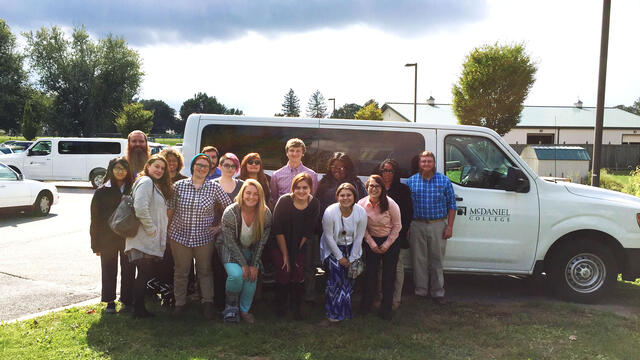Course on religion in prison rattles students’ preconceptions
“Religion and American Prisons” seems an odd combination and an even stranger course title, but the 25 students in Religious Studies professor Brad Stoddard’s class applaud their studies as surprising, thought provoking and at times even shocking.

Professor Brad Stoddard with students from his "Religion and American Prisons" course
“Religion and American Prisons” seems an odd combination and an even stranger course title, but the 25 students in Religious Studies professor Brad Stoddard’s class applaud their studies as surprising, thought provoking and at times even shocking.
The course examines the relationship between religion and prisons in America — a nation that incarcerates more prisoners per capita than any other society today or in history, says Stoddard, whose Ph.D. and post-doctoral studies have focused on religion and prisons. Across the U.S., roughly 700 of every 100,000 people are incarcerated. In Louisiana, known as the prison capital of the world, that number jumps to over 1,600 per 100,000 people.
America is the land of mass incarceration costing billions of dollars each year. And in the past two decades, says Stoddard, the U.S. has asked religion to step in.
“Religion is the most common form of rehabilitation in many prisons,” Stoddard says, explaining that the justice system is hoping that if inmates turn to God, they won’t commit crimes when they are released.
Shrinking government social services have redirected people to religious organizations to find the help they need. And that is especially true, Stoddard says, in the prison system. It is the prison chaplain who often supplies goods and services that the prison system doesn’t and these goods and services are donated by the religious community outside the prison. Prisons have so many religious volunteers, they have a separate person — the chaplain — to coordinate them.
During their tour of the women’s Maryland Correctional Institution at Jessup, the students saw firsthand the integral role religion plays in prison. From “Orange is the New Black” to “Law and Order” and even Facebook, students discovered a society very different from how it is portrayed on television and social media — a society that depends on religion for supplies, services and ultimately rehabilitation.
Inmates with families who send them care packages with shoes, clothing, personal hygiene items, books and food are the lucky ones — others must rely on donations distributed by the chaplain and largely donated by religious groups.
“The course and the trip to the women’s prison really opened my eyes,” says sophomore Psychology major Savaughna Monteith of Rockville, Md. “Religion has influenced so much in the criminal justice system.”
Students were surprised at every turn. They found “real people trying to better themselves.” They wondered what the inmates could possibly have done to be sent to prison in the first place. Some inmates were sewing a flag for Baltimore’s Fort McHenry that seemed to be half the size of a football field; others were training service dogs and processing the paperwork for license plates that would be sent to the men’s prison for completion. Two women embroidering police uniforms, vests and sweatshirts talked about opening their own shop once they were released.
Relationships between inmates and guards were often based on religion they shared on the outside — and among all prison employees, the chaplain is the only one encouraged to show some affection.
The students discovered that practically all inmates are involved in religious classes or education — more so than in either vocational or educational programs — and new partnerships between religion and the state have increased in the past 20 years. Almost half of American prisons have faith-based dorms, and Florida has three faith-based prisons. The Louisiana State Penitentiary at Angola was first in the nation to have a seminary program more than 20 years ago, and 10 states have expressed interest in prison seminary programs.
“Suffice it to say that religion and prisons will be connected for quite some time, especially here in America, and this speaks as much for the positive aspects as it does for the bad,” says Bill Nash, a former Marine who actually worked in the prison installing fire protection systems before becoming an Environmental Studies major at McDaniel. “The course really got me thinking about the American prison system in a different way — specifically I am interested in the impacts on the American economy resulting from the prison system. The states are looking to religion to save them some money.”
Based on criminal justice trends, it looks like religion will continue to play a larger role in prisons for two reasons, Stoddard says.
“For better or worse, there’s still a dominate idea that religion both reduces recidivism rates and makes inmates more manageable inside prisons,” he says. “Additionally, religious volunteers and programs provide free or low-cost forms of rehabilitation in prison.”
Most of the students found these realities rather eye-opening.
“Separation of church and state?” says Allison Isidore, a sophomore with a double major in History and Religious Studies from Montclair, N.J. “It doesn’t exist. Religion and prison are intertwined.
“I didn’t realize how big of an impact religion has had on not only our prisons but on the entire criminal justice system from rehabilitation to supplying necessities to inmates.”
Religious studies professor Brad Stoddard (left, back row, with beard) posed for a photo with his Religion and American Prisons class before they visited the women's Maryland Correctional Institution at Jessup.